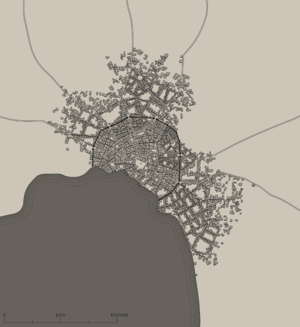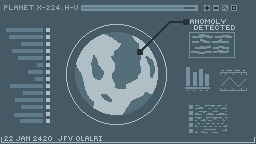Difference between revisions of "User:Caelphon"
m |
|||
| Line 5: | Line 5: | ||
{{toc_right}} | {{toc_right}} | ||
=Epsilon Ursae Minoris | =Qerr'Naal= | ||
[[File:Qerr'Naal.png|thumb|alt=Qerr'Naal|The sprawling metropolis, Qerr'Naal.]] | |||
Qerr'Naal is the bustling planetary capital of [[Epsilon Ursae Minoris]], often being called the Mother City by the vast majority of its population. The singular, and most populous, settlement across the planet - Qerr'Naal is home to over twenty million Dionae who are governed by the Elder Council, Dionae that directly impose restrictions and leniencies across the metropolis through the planet's Rootsong Network. | |||
Officially founded after Skrell probes discovered it in '''2420 CE''', when it was nothing but a series of conjoined villages, Qerr'Naal has undergone various upliftments to transform it to a bustling city capable of sustaining the Dionae within the segment of coast that it expands across. | |||
==Districts== | |||
The urban geography of Qerr'Naal is influenced by the coastal contour, that expands deep into the highlands north-west of the settlement. These geographic features in part divide the city into several commonly districts - many of which developed historically together and share common attributes of language and culture. | |||
===Fioxit Bowl=== | |||
The Fioxit Bowl is considered the most industrialized sector of Qerr'Naal - found along the coast outside of the city walls, it has seen an expansion further into the coast in order to power their manufacturing process through tidal power generated by the restless Qlep Ocean. Dionae have even begun incorporating themselves into the abandoned warehouses in order to decrease the commute from the city to the industrial sector, nicknaming themselves Metpok - loosely translating to Warehouse Migrants. | |||
===Huxul Gardens=== | |||
The Huxul Gardens contains a bulk of the residential area - stretching from either end of the city's gates. The majority of the buildings perhaps beside a handful, within the gates, are residential blocks capable of hosting thousands of Dionae due to their design being essentially vertical gardens powered by various solar arrays on their roofs. Formerly tribes, the Huxul Gardens have undergone vigorous upliftments in order to support the growing population of Dionae. | |||
===Vurdok Flats=== | |||
The Vurdok Flats houses most of the commercial sector - found outside the northern and western gates of Qerr'Naal, Vurdok Flats has become well-known for its subversive elements. Composed of various tourist activities such as pubs, nightclubs, casinos etc it isn't a seldom sight to experience muggings or petty crime, but most simply agree that its part of the experience even if it involves losing one's purse during the trip. Most of the police force is stationed within the Flats, quickly discernable from the other Dionae thanks to their open-carry of Sonic Weaponry built to disable Dionae in mere moments by release frequencies designed to paralyse the species for brief periods. | |||
==Education== | |||
Qerr'Naal has become somewhat infamous for their education - hosting the '''Dialxi University''' that offers free education to the Dionae, and only Dionae. Whilst it has caused some internal conflict between the non-Dionae inhabitants, most have welcomed the University with open arms due to exponentially increasing the opportunities for the Dionae across the planet - even allowing some to get employment in other galactic markets. | |||
== | ==History== | ||
[[File:EUMDISC.png|thumb|alt=Discovery|Discovered in 2420 CE - Epsilon Ursae Minoris would never be the same again.]] | |||
The earliest known traces of Dionae in the region were found at Groggam Cave in the vicinity of the Vurdok Flats - dating to between 15,000 and 12,000 years ago. Little is known of the history of the region's first residents, due to the lack of written history from the area before it first made its' rounds across the Jargon Federation. Most of the population simply see it is a step in the evolution of the Dionae, tending not to probe too deeply into the planet's history. | |||
Its discovery in '''2420 CE''', and its prompt introduction to the galactic community by the Jargon Federation, was followed by a brief period of cultural shock. Whilst the Dionae acknowledged the stars, even with the assistance of the Deathflower Journal, it was largely believed that the Dionae were alone in the Universe - created to explore and discover the stars by themselves. It wasn't until '''2432 CE''' that the Dionae accepted their position within the intergalactic community and graciously welcomed any assistance from the extraterrestrials - especially in terms of technology that could allow them to traverse the stars. | |||
''' | |||
The ensuing space race pushed the Dionae into the stars - using crude propulsion systems to explore their home system as the Elder Council was established - and thus, present day Qerr'Naal was birthed. | |||
Revision as of 09:15, 16 November 2020
| Dionae Lore Pages | ||
|---|---|---|
| Species | Dionae · Dionae Forms · Dionae Mindtypes · Dionae Biology · Dionae Out-Of-Character | |
| Locations, Planets & Systems | Covenant of Xrim · Hieroaetheria · Rueltab · Primitive Sirens of Mictlan · Eternal Gardens | |
| Conglomerates & Factions | Dionae in the Federation · Dionae in the Hegemony · Vaurcae & Dionae · The Narrows · Minor Dionae Factions | |
| Culture, History & Society | Dionae Culture · Notable Dionae · Voidic Proto-Culture · Dionae Space Capabilities · Dionae History · Dionae Integration · The Eternal | |
| Lore Arcs | Omnivirate's Providence | |
Qerr'Naal
Qerr'Naal is the bustling planetary capital of Epsilon Ursae Minoris, often being called the Mother City by the vast majority of its population. The singular, and most populous, settlement across the planet - Qerr'Naal is home to over twenty million Dionae who are governed by the Elder Council, Dionae that directly impose restrictions and leniencies across the metropolis through the planet's Rootsong Network.
Officially founded after Skrell probes discovered it in 2420 CE, when it was nothing but a series of conjoined villages, Qerr'Naal has undergone various upliftments to transform it to a bustling city capable of sustaining the Dionae within the segment of coast that it expands across.
Districts
The urban geography of Qerr'Naal is influenced by the coastal contour, that expands deep into the highlands north-west of the settlement. These geographic features in part divide the city into several commonly districts - many of which developed historically together and share common attributes of language and culture.
Fioxit Bowl
The Fioxit Bowl is considered the most industrialized sector of Qerr'Naal - found along the coast outside of the city walls, it has seen an expansion further into the coast in order to power their manufacturing process through tidal power generated by the restless Qlep Ocean. Dionae have even begun incorporating themselves into the abandoned warehouses in order to decrease the commute from the city to the industrial sector, nicknaming themselves Metpok - loosely translating to Warehouse Migrants.
Huxul Gardens
The Huxul Gardens contains a bulk of the residential area - stretching from either end of the city's gates. The majority of the buildings perhaps beside a handful, within the gates, are residential blocks capable of hosting thousands of Dionae due to their design being essentially vertical gardens powered by various solar arrays on their roofs. Formerly tribes, the Huxul Gardens have undergone vigorous upliftments in order to support the growing population of Dionae.
Vurdok Flats
The Vurdok Flats houses most of the commercial sector - found outside the northern and western gates of Qerr'Naal, Vurdok Flats has become well-known for its subversive elements. Composed of various tourist activities such as pubs, nightclubs, casinos etc it isn't a seldom sight to experience muggings or petty crime, but most simply agree that its part of the experience even if it involves losing one's purse during the trip. Most of the police force is stationed within the Flats, quickly discernable from the other Dionae thanks to their open-carry of Sonic Weaponry built to disable Dionae in mere moments by release frequencies designed to paralyse the species for brief periods.
Education
Qerr'Naal has become somewhat infamous for their education - hosting the Dialxi University that offers free education to the Dionae, and only Dionae. Whilst it has caused some internal conflict between the non-Dionae inhabitants, most have welcomed the University with open arms due to exponentially increasing the opportunities for the Dionae across the planet - even allowing some to get employment in other galactic markets.
History
The earliest known traces of Dionae in the region were found at Groggam Cave in the vicinity of the Vurdok Flats - dating to between 15,000 and 12,000 years ago. Little is known of the history of the region's first residents, due to the lack of written history from the area before it first made its' rounds across the Jargon Federation. Most of the population simply see it is a step in the evolution of the Dionae, tending not to probe too deeply into the planet's history.
Its discovery in 2420 CE, and its prompt introduction to the galactic community by the Jargon Federation, was followed by a brief period of cultural shock. Whilst the Dionae acknowledged the stars, even with the assistance of the Deathflower Journal, it was largely believed that the Dionae were alone in the Universe - created to explore and discover the stars by themselves. It wasn't until 2432 CE that the Dionae accepted their position within the intergalactic community and graciously welcomed any assistance from the extraterrestrials - especially in terms of technology that could allow them to traverse the stars.
The ensuing space race pushed the Dionae into the stars - using crude propulsion systems to explore their home system as the Elder Council was established - and thus, present day Qerr'Naal was birthed.









